During the American Civil War in the mid-19th century, often classified as the first modern war, we witnessed the northern armies use of railroads and warships to provide logistical support. This was a first. Prior to the Civil War railroads were never used in this way and much of the North’s strategy involved keeping the transportation network intact and enhancing it. This meant deploying the army corp of engineers in building bridges, maintaining tracks and keeping waterways open. Without transportation and logistical support the Sherman 1864 campaign through Georgia would never have been possible. And on the water, steam replaced sail, and iron replaced wood, advancing the development of marine technology that would dramatically alter commercial transportation after the war.
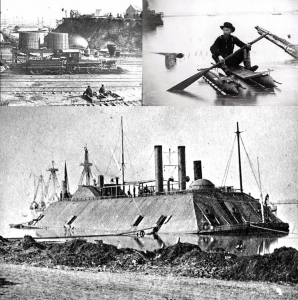
In World War One, motorized transport and railroads lent logistical support to all major combatants. For Germany, at the outset of the war, its extensive railroad network built for both commercial and military logistical purposes, gave them significant advantages in carrying out the initial offensive on the Western Front. Trucks and automobiles increasingly appeared behind the front lines although horse-drawn transport from the rail head remained the principal way armies received supplies. The perfection of caterpillar track drives combined with the internal combustion engine led to the development of the tank, the most significant mechanized mobile innovation of the war. Ironclad surface fleets and submarines prowled the sea lanes. And overhead we saw the development of airships, bombers and fighter aircraft.
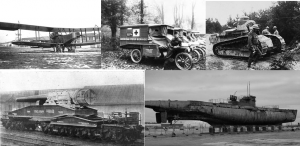
World War Two further advanced mechanized transport with all of the technologies of World War One undergoing dramatic enhancements. Tanks and trucks provided the means by which the German, British, Soviet and American armies moved massive numbers of troops and material across thousands of kilometers in Europe, North Africa and Asia. The development of synthetic rubber greatly contributed to the fielding of vast fleets of trucks. On the water the aircraft carrier replaced the battleship as the dominant surface vessel while submarines increasingly improved over the course of the war. By the end the Germans introduced jet fighter aircraft and the first ballistic missile but in insufficient quantity to alter the war’s end result. World War Two also brought us the helicopter, a technology that was to play a much larger role in subsequent wars fought in the 20th and now in the 21st century.
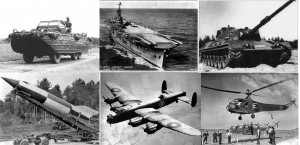
At the end of World War Two the world entered the atomic age and U.S. military research discovered a way to create nuclear propulsion systems that could be deployed on warships. The first of these was the USS Nautilus, a nuclear-powered submarine launched in 1955. Today’s American aircraft carrier fleet is nuclear powered and so is the submarine fleet. The power plants are small nuclear reactors that generate heat to drive turbines which generate electricity. Nuclear powered ships have remained largely in the military domain although a number of merchant cargo ships and icebreakers have been built to operate using the same technology. And the United States isn’t alone in operating nuclear power in ships. It was quickly joined by the Soviet Union and now Russia. Russia’s ice breaker fleet includes nuclear powered vessels. It’s submarine fleet also includes nuclear powered vessels. The United Kingdom and France have both built a fleet of nuclear powered submarines. As of August 2012 there were 140 ships operating using nuclear marine propulsion around the globe.

But nuclear has not translated to land and air transportation. There are no nuclear powered tanks, automobiles, trains or trucks. There are no nuclear powered aircraft. This is largely because of the necessary safeguards associated with the technology. Nuclear technology requires protective encasement to ensure no radiation leakages or potential for accidents. On a nuclear-powered aircraft carrier with multiple power plants, the infrastructure of the ship easily handles the load, and because the ships are at sea any accident can be localized to the surrounding marine environment. Such would not be the case if a nuclear-powered train derailed in or near a city, or if a nuclear-powered airplane crashed, or nuclear powered automobiles and trucks were to crash.
So where is the military having the greatest impact on transportation innovation today? A look at the Defense Advanced Research Projects Agency in the United States and its funded projects to give you an idea of what the future holds. A collage of new project ideas appear in the images below.
- Seawater powered naval vessels. Currently the American Navy is experimenting with an on board technology to convert seawater to jP-5 jet fuel. Eventually the goal is to produce fuel for ongoing use by naval ships for long duration assignments without the need for tanker support. And robotic submarines that can attain speeds of up to 160 kilometers (100 miles) per hour.
- FANG stands for Fast, Adaptable and Next Generation. It describes a series of next generation amphibious and land vehicles using crowdsourcing to come up with new designs.
- Continuous work on the development of autonomous vehicles that require no human driver including robotic helicopters, jet aircraft, support ground vehicles, and marine vessels.
- Personal transport technologies to improve individual field operations, a military version of the Segway.
- Exoskeleton technologies that enhance human physical capability similar to fantasy, science fiction technology as worn by Iron Man. Exoskeletons like the Hulc allow a soldier to carry much more equipment into battle and easily manage walking at high speed over difficult terrain.
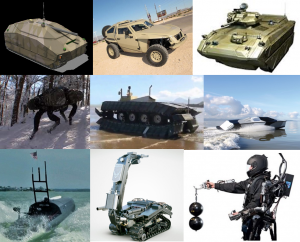
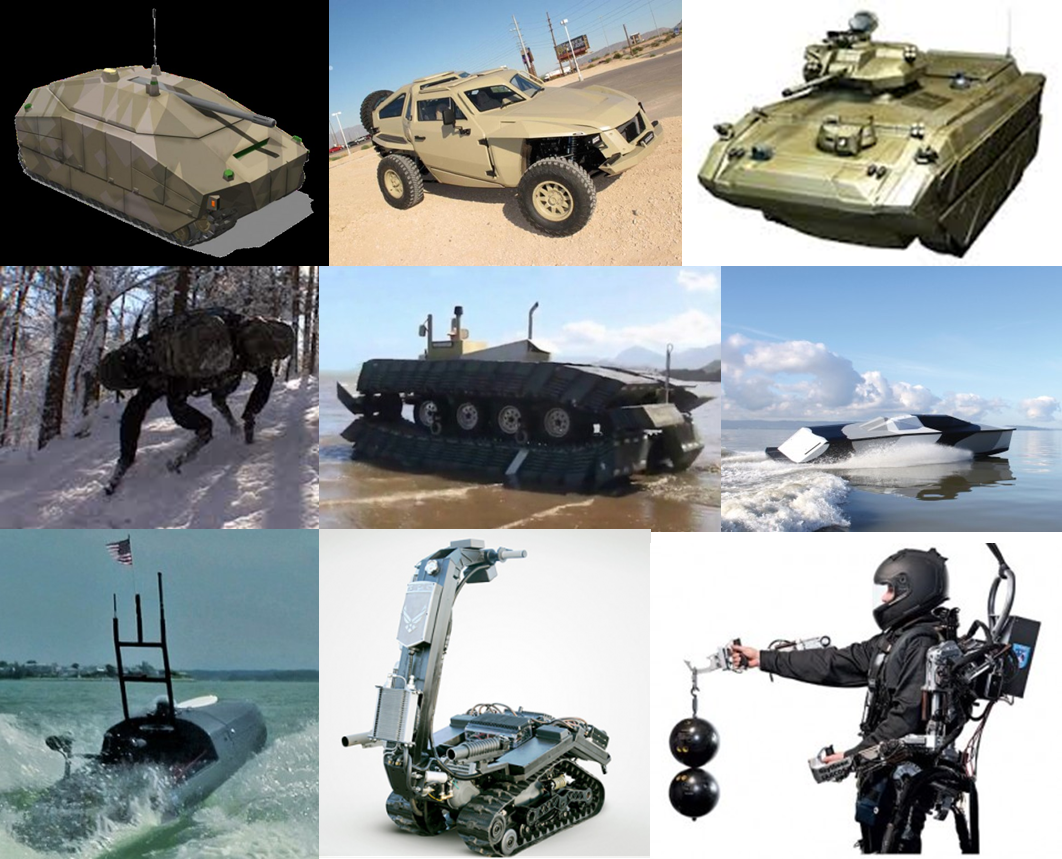








Len says: “Seawater powered naval vessels. Currently the American Navy is experimenting with an on board technology to convert seawater to jP-5 jet fuel. Eventually the goal is to produce fuel for ongoing use by naval ships for long duration assignments without the need for tanker support. And robotic submarines that can attain speeds of up to 160 kilometers (100 miles) per hour.”
“Seawater powered” naval vessels will have to be nuclear powered navel vessels. The large amount of energy required for the seawater “conversion” can only come from nuclear power, and the process would require large vessels to house and support the chemical plant. This boondoggle concept is less viable than Solendra.
Len says: “And robotic submarines that can attain speeds of up to 160 kilometers (100 miles) per hour.”
That sounds more like a “robotic” torpedo or naval mine than a submarine. Anything traveling 100 mph submerged must be expending energy at such a high rate that it must either be nuclear powered or very short-ranged. Seems unlikely any major power will build and operate unmanned nuclear-powered submarines. Supremacy at sea must depend on space-based assets, aircraft, missiles, and “smart” mines. Advanced SUBROCS and Harpoons are the most feasible solution to high-speed attack on warships by submarine. The Russians have invested heavily, and probably unwisely, into super cavitation high-speed torpedo technology, and many analysts speculate the required hazardous high energy density propellants led to the Kursk explosion and sinking. Western Navies well-understand this sort of technology, and view it as just too hazardous to deploy, and they have more effective alternatives. The Russians might have developed it with hopes of sales and influence with nations lacking space-based assets, and without industrial capability to produce SUBROCs and Harpoon missiles. It’s likely the Kursk disaster sank these hopes along with the Kursk.
All surface vessels are extremely vulnerable to missile attack, and for all practical purposes are defenseless against the present generation of first-world nation missiles. It’s already problematic whether a nuclear submarine can destroy an “enemy” nuclear submarine with a torpedo, regardless of the torpedo’s speed. The high-speed torpedo concept seems to be a hazardous solution in search of a problem that would justify the risks.
The technology for seawater conversion is installed on a nuclear powered aircraft carrier. The submarines are included in a list of DARPA funded projects. The plan is for them to be mini-subs and unmanned. As for the practicality of any of this all I can say is DARPA funds some viable projects and others that utterly fail so it would not be a surprise if ideas conceived on a wish list turn out to be untenable.